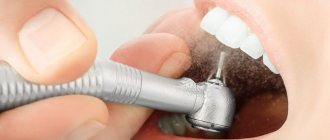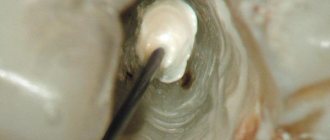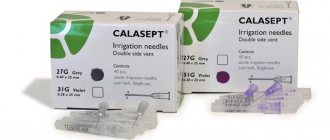It is no secret that calcium is necessary for the formation of bone and dental tissue. In this regard, a completely logical question arises: is it possible to consume additional calcium to strengthen teeth? Dentists unanimously state that during the formation of teeth (and this is during childhood), this macronutrient is extremely necessary, but in adults calcium will not be able to improve their condition. To strengthen tooth enamel, special dental procedures are recommended for adults. In St. Petersburg they are carried out by specialists from Nurimed dentistry. You can make an appointment with a doctor by calling.
Proper nutrition: calcium for dental health
Lack of calcium in the body leads to multiple health problems, and affects not only the condition of the teeth. A sufficient amount of this macroelement is responsible for the health of the endocrine and cardiovascular systems. Calcium regulates processes occurring in the nervous system and affects blood clotting. If a person does not receive enough of this substance, then the body independently solves this problem by obtaining calcium from the bones.
You can eat many foods high in calcium, but this will not help improve the health of your teeth or slow down tooth decay. However, following the rules of a healthy diet, drawing up a daily diet taking into account all vital vitamins and macroelements is important in order to maintain your body and not aggravate the situation.
Where is calcium found?
Indeed, in the human body, calcium is mainly found in bone tissue, tooth enamel and dentin - the basis of teeth. In total, 99% of it is there. And only one percent of this mineral is found in other tissues - muscles, blood, intercellular fluid. But this one percent is very important: it ensures muscle contraction, including the heart muscle, regulates the functioning of the nervous system, participates in the process of blood clotting, and helps the endocrine system. And therefore, if the body lacks it, it comes from the bones, which are a kind of storage of this element.
Usage rate
Throughout a person’s life, the required amount of calcium changes:
- Infants under 6 months need 200 mg daily.
- Children from 7 months to one year need 260 mg per day.
- Between the ages of one and three years, a child needs 700 mg.
- Children from 4 to 8 years old need 1000 mg of the macronutrient daily.
- A maximum dose of 1300 mg/day is needed for ages 9-18 years.
- Women aged 19 to 50 years need 1000 mg of calcium per day.
- Men aged 19 to 70 years need 1000 mg per day.
- Women aged 51 years and older need 1200 mg daily.
- Men 71 years of age and older require 1,200 mg of calcium per day.
The greatest amount of calcium is needed by a person in childhood and adolescence, when permanent teeth appear. This is due to the fact that the macroelement accumulates in the teeth only during their formation. And the further condition of the teeth depends on how much this supply is replenished. Unfortunately, it will not be possible to influence the health of molars by consuming calcium-containing foods.
Calcium content in foods: replenishing calcium deficiency
Macronutrient deficiency can manifest itself in different ways. Here are its main features:
- Brittleness of nails.
- Hair fragility and loss.
- Dryness and itching of the skin.
- Pain in muscles, joints.
- A tingling feeling in the muscles.
- Frequent seizures.
- Loss of energy, lethargy, chronic feeling of fatigue and drowsiness.
If you notice signs of calcium deficiency, you can compensate for the deficiency by adjusting your daily diet.
Calcium is found in milk and dairy products (yogurt, cheese). But what about people who don’t use them? You should know that this macronutrient is also present in other products.
Fish and seafood are known for their beneficial properties. The beloved sardine in oil can rightfully be considered a storehouse of calcium. 100 grams of this canned food contains 383 mg of macronutrients. There is also calcium in shrimp. There are 90 mg of calcium per 100 grams of shrimp.
Calcium is also found in products of plant origin. The record holder among them is sesame. 100 grams of seeds contain 780 mg of calcium. One serving of white beans (approximately 175 ml) contains up to 141 mg of the macronutrient; beans contain slightly more - 194 mg. 100 grams of almonds contain 263 mg of calcium. Cauliflower will replenish 95 mg of calcium in the body with one 125 g serving. Broccoli also contains this macronutrient: 47 mg of calcium per 100 grams.
Good news for those with a sweet tooth is the information that calcium is also found in chocolate. By choosing a 100 gram milk chocolate bar, you will get up to 240 mg of calcium. But here it should be remembered that sweets in themselves are not good for teeth, so you should not choose chocolate as the only source of this macronutrient.
When introducing foods rich in calcium into your diet, you should know that it is not absorbed by the body by itself. To achieve the desired effect, it is necessary that other beneficial substances and vitamins enter the body. In particular, vitamin D3 is responsible for the absorption of calcium (on average, it needs 0.636 mg per day).
Calcium hydroxide: yesterday, today, tomorrow
Authors:
1st Department of Therapeutic Dentistry BSMU L.A. Kazeko, I.N. Fedorov Calcium hydroxide: yesterday, today, tomorrow
Calcium hydroxide Ca(OH)2 is a strong base, slightly soluble in water. A saturated solution of calcium hydroxide is called lime water and is alkaline. In air, limewater quickly becomes cloudy due to the absorption of carbon dioxide and the formation of insoluble calcium carbonate [3].
Calcium hydroxide (“slaked lime”) is a white, very fine powder, slightly soluble in water (1.19 g/l), solubility can be increased by glycerin and sucrose. Hydrogen index (pH) is about 12.5. Calcium hydroxide is very sensitive to contact with atmospheric carbon dioxide, which transforms it into calcium carbonate. The drug should be stored in sealed packaging away from light; it can be stored in a supersaturated aqueous solution (distilled water) in an airtight bottle.
The basis for the use of calcium hydroxide in endodontics was information about the etiology and pathogenesis of pulpitis and apical periodontitis. The most common cause of these diseases is microorganisms in the root canal system of the tooth. Kakehashi et al. (1965), Moller et al. (1981) showed in experiments that periapical inflammation and destructive processes around the apex of the tooth develop only with the participation of root canal microorganisms [2, 5, 15]. Favorable factors for the existence of microflora are the complex anatomy of the root canals, the ability of bacteria to penetrate into the dentinal tubules to a depth of 300 microns, anaerobic development conditions, the ability to feed from living or necrotic pulp, salivary proteins, and periodontal tissue fluid. Thus, the quality of endodontic treatment is determined by the quality of disinfection of the root canal system [6, 11].
Endodontic instrument breakage, root perforation, ledges, and overfilling or underfilling are considered to be the main causes of endodontic failure. However, in most cases, these errors do not affect the outcome of endodontic treatment until a concomitant infection occurs. Of course, gross errors prevent or make it impossible to complete intracanal procedures, but the chances of successful treatment increase significantly if the infectious and toxic contents of the root canals are effectively removed before filling.
Microorganisms that survive instrumentation and irrigation quickly multiply and repopulate root canals that remain empty between visits [1, 5]. The likelihood of reinfection depends on the quality of root canal filling and the usefulness of the coronal restoration. However, in all cases where bacteria remain in the root canal system, there is a risk of further development of periapical changes [4, 18].
In untreated teeth with primary intracanal infection, one or more species of bacteria are usually present, with no apparent predominance of facultative or anaerobic forms. In case of secondary infection if treatment fails, a mixed infection is present, with gram-negative anaerobic strains dominating [1, 4].
There are differing opinions regarding the necessary number of treatment steps for patients with periapical problems. Thus, some authors justify the need to treat infected root canals in several visits, using temporary intracanal dressings, which allows for the gradual and controlled destruction of microorganisms in them. Others suggest preventing the growth of remaining microorganisms by depriving them of nutrition and living space by fully debridement, disinfection, and 3D filling of the root canals during the first and only visit.
Anti-inflammatory and antibacterial activity of calcium hydroxide
Instrumental treatment of the root canal reduces the number of microorganisms by 100–1000 times, but their complete absence is observed only in 20–30% of cases. Antibacterial irrigation with 0.5% sodium hypochlorite solution increases this effect to 40–60% [2]. It is very difficult in practice to achieve complete disinfection of infected root canals even after complete mechanical cleaning and irrigation with antiseptic solutions. It is possible to destroy bacteria remaining in the root canal by temporarily filling the root canal with antimicrobial agents until the next visit. Such drugs should have a wide spectrum of antibacterial action, be non-toxic and have physicochemical properties that allow them to diffuse through the dentinal tubules and lateral canals of the tooth root system [6, 8].
Calcium hydroxide is widely used as a temporary intracanal agent in endodontics, which decomposes into calcium ions and hydroxide ions in an aqueous solution. The main biological properties of hydroxide: bactericidal activity, anti-inflammatory properties, tissue solubility, hemostatic effect, inhibition of tooth tissue resorption, stimulation of bone regeneration processes [2, 4, 19].
Calcium hydroxide has bactericidal activity due to its high alkalinity and the release of hydroxide ions - highly active free radicals - in the aqueous environment. Their effect on bacterial cells is explained by the following mechanisms:
– damage to the cytoplasmic membrane of the bacterial cell, which plays an important role in the preservation of the cell. It is the cell membrane that provides selective permeability and transport of substances, oxidative phosphorylation in aerobic strains, production of enzymes and transport of molecules for the biosynthesis of DNA, cellular polymers and membrane lipids. Hydroxide ions from calcium hydroxide cause lipid oxidation, which leads to the formation of free lipid radicals and the destruction of phospholipids, which are structural components of cell membranes. Lipid radicals initiate a chain reaction, as a result of which unsaturated fatty acids are lost and cell membranes are damaged;
– denaturation of proteins due to the fact that the alkaline environment of calcium hydroxide causes the destruction of ionic bonds that provide the structure of proteins. In an alkaline environment, the polypeptide chains of enzymes are chaotically combined and transformed into disordered formations. These changes often lead to loss of biological enzyme activity and disruption of cellular metabolism;
– damage to microbial DNA, with which hydroxide ions react, causing its cleavage and leading to damage to genes due to disruption of DNA replication. In addition, free radicals can independently cause destructive mutations.
The bactericidal effect of calcium hydroxide depends on the concentration of hydroxide ions, which is high only in the area of direct contact with the drug. When calcium hydroxide diffuses deeper into dentin, the concentration of hydroxide ions decreases due to the action of buffer systems (bicarbonate or phosphate), acids, proteins and CO2, and the antibacterial activity of the drug may decrease or slow down [1]. Neutralization of high pH calcium hydroxide can also occur as a result of coronal microleakage, leakage of tissue fluid through the root apex, the presence of necrotic masses in the canal, and the production of acidic substances by microbes. In the root canal the pH is 12–12.5, in the adjacent dentin, where there is close contact with the hydroxide, the pH varies from 8 to 11, and in the depths of the dentin the pH values are 7–9. The highest pH values were obtained in the period from 7 to 14 days after adding an aqueous suspension of calcium hydroxide to the channel [1, 2].
Microorganisms differ in their resistance to changes in pH; most of them reproduce at pH 6–9. Some strains can survive at pH 8–9 and are usually the cause of secondary infection. Enterococci (E. faecalis), resistant to pH 9–11, are not normally found in root canals or are present in small quantities in untreated teeth. They play an important role in unsuccessful endodontic treatment and are often (32–38% of cases) present in teeth with apical periodontitis.
One of the important components of the effective disinfectant effect of the drug in endodontics is its ability to dissolve and penetrate into the root canal system. Alkalis (NaOH and KOH) are highly soluble and can diffuse deeper than calcium hydroxide. These substances have pronounced antibacterial activity. But high solubility and active diffusion enhance the cytotoxic effect on the cells of the body. Due to their high cytotoxicity, they are not used in endodontics. Calcium hydroxide is biocompatible, since due to its low water solubility and diffusion, a slow increase in pH occurs, which is necessary to destroy bacteria localized in dentinal tubules and other hard-to-reach anatomical formations. Because of these features, calcium hydroxide is an effective but slow-acting antiseptic [1, 5, 19].
The time required for optimal root canal disinfection with calcium hydroxide has not yet been precisely determined. Clinical studies provide conflicting results. Cwikla et al. (1998) found that in 90% of cases there was no bacterial growth after 3 months of hydroxide use [13]. In a study by Bystrom et al. (1999) calcium hydroxide effectively killed microorganisms within 4 weeks of use. Reit and Dahlen used the drug for 2 weeks - infection persisted in 26% of root canals [2]. In an experiment by Basrani et al. After one week of using calcium hydroxide, bacteria remained in the canals in 27% of cases [12].
Mechanisms of resistance of microorganisms to the action of intracanal disinfectants
Factors that determine the resistance of microorganisms to the action of disinfectants and the ability to survive after the use of intracanal (temporary and permanent) filling materials:
— neutralization of the drug by buffer systems or products of bacterial cells;
— exposure of the disinfectant in the root canal is insufficient to destroy microorganisms;
— low antibacterial effectiveness of the drug against root canal microorganisms;
— the effect of the drug on microorganisms is limited for anatomical reasons;
— the ability of microorganisms to change their properties (genes) after environmental changes [1, 4].
An important mechanism of bacterial resistance is their existence in the form of a biofilm. Biofilm is a microbiological population (bacterial ecosystem) associated with an organic or inorganic substrate, surrounded by bacterial waste products. Various strains of microorganisms collected in a biofilm are capable of organizing associations for joint survival and have increased resistance to antimicrobial agents and protective mechanisms [10]. Over 95% of naturally occurring bacteria are found in biofilms.
It is more difficult to destroy bacteria in biofilms than in planktonic suspensions unless the disinfectant has the ability to dissolve tissue. When re-treating infected teeth, calcium hydroxide cannot 100% kill persistent bacteria (E. faecalis), which is able to multiply between dental visits. Of great importance is a complete preparation and cleansing of the canal from all microorganisms on the first visit (using copious rinses with sodium hypochlorite). Prevention of re-infection of the root canal is achieved by completely sealing the tooth crown using high-quality temporary fillings [4].
Effect of solvents on the antibacterial activity of calcium hydroxide
Substances used as a medium for calcium hydroxide have different water solubility. An optimal environment should not change the pH of calcium hydroxide. Many solvents do not have antibacterial activity, such as distilled water, saline, and glycerin. Phenol derivatives, such as paramonochlorophenol, camphor phenol, have pronounced antibacterial properties and can be used as a hydroxide medium. Calcium hydroxide with paramonochlorophenol has a long range of action and destroys bacteria in areas remote from the places where the paste is applied [5].
Siqueira et al. found that calcium hydroxide in saline does not kill E. faecalis and F. nucleatum in dentinal tubules within a week of use. And calcium hydroxide paste with paramonochlorophenol and glycerol effectively killed bacteria in the tubules, including E. faecalis, within 24 hours of use. That is, paramonochlorophenol enhances the antibacterial activity of calcium hydroxide [20].
The results of a study on the disinfection of dentinal tubules using three preparations of calcium hydroxide (Ca(OH)2 in distilled water, Ca(OH)2 with potassium iodide and Ca(OH)2 with iodoform (Metapex)) showed that Ca(OH)2 in in its pure form it is less effective in killing microbes in dentinal tubules. In channels with calcium hydroxide, growth of some microorganisms (E. faecalis, C. albicans) to a depth of 250 µm was observed for 7 days. This is explained by the fact that Ca(OH)2 has a low degree of permeability and its high pH (12) is partially neutralized by dentin buffer systems. Ca(OH)2 with potassium iodide is more effective than pure hydroxide. But Metapex paste (Ca(OH)2 with iodoform) turned out to be the most effective: in addition to E. faecalis, it neutralized other microbes and penetrated into the tubules to a depth of more than 300 μm (Cwikla et al.) [1, 13].
Abdullah et al. (2005) studied the effectiveness of various intracanal agents (calcium hydroxide, 0.2% chlorhexidine, 17% EDTA, 10% povidone-iodine, 3% sodium hypochlorite) against E. faecalis strains contained in bacterial biofilms. As part of the biofilm, E. faecalis was killed in 100% of cases by 3% sodium hypochlorite after 2 minutes and 10% povidone-iodine after 30 minutes. Calcium hydroxide partially eliminated these bacteria [9].
Since some microorganisms, especially E. faecalis, are resistant to calcium hydroxide, its combination with other antimicrobial agents that increase its activity, for example, idoform, camphor paramonochlorophenol, is justified. Having low surface tension, fat-soluble phenols penetrate deep into tooth tissue.
In endodontics, chlorhexidine, which is effective against many bacteria that cause endodontic infection, is recommended for widespread use as an irrigant and intracanal dressing. The chlorhexidine molecule, interacting with the phosphate groups of the bacterial cell wall, penetrates the bacterium and has an intracellular toxic effect [12, 19].
Calcium hydroxide in combination with 2% chlorhexidine gel has increased antimicrobial activity, especially against resistant microorganisms. Chlorhexidine in gel form has such positive properties as low toxicity for periodontal tissues, viscosity, which allows the active substances to be kept in constant contact with the walls of the root canal and dentinal tubules, and water solubility. The combination of chlorhexidine gel and calcium hydroxide against E. faecalis in infected root dentin has been found to be highly effective [15]. High pH (12.8) in the first two days increases the penetration ability of the drugs.
Effective against E. faecalis after 1, 2, 7 and 15 days of application of 2% chlorhexidine gel. According to Gomes et al., 2% chlorhexidine gel has greater antibacterial activity against E. faecalis than calcium hydroxide, but this ability is lost when used for a long time. This is confirmed by other studies, even when using chlorhexidine in the form of a solution or gel at concentrations of 0.05%, 0.2% and 0.5%. The combination of chlorhexidine and calcium hydroxide inhibits the growth of E. faecalis by 100% after 1-2 days of contact [12, 15].
Calcium hydroxide as a physical barrier
Secondary intracanal infections are caused by microorganisms that enter the canal during treatment, between visits or after dental treatment. The main sources of secondary infection: dental plaque on teeth, caries, infected endodontic instruments. Causes of infection between visits may include microleakage through a temporary filling due to its destruction; tooth fracture; delay in replacing a temporary filling with a permanent one, when the tooth remains open for drainage. Secondary infection allows the emergence of new, virulent microorganisms that cause acute periapical inflammation [4, 7].
Intracanal preparations destroy bacteria remaining after chemomechanical treatment of the canal, and are also used as a physical and chemical barrier that prevents the proliferation of microorganisms and reduces the risk of reinfection from the oral cavity. Reinfection of the canal is possible due to the fact that the drug is dissolved by saliva, saliva seeps into the space between the medication and the walls of the canal. However, if a drug has an antibacterial effect, it will first be neutralized and only then will bacterial invasion occur.
To prevent reinfection, the sealing ability of calcium hydroxide is more important than its chemical activity, since it has low water solubility, dissolves slowly in saliva, remains in the canal for a long time, delaying the movement of bacteria towards the apex [4, 5]. Despite the use of solvents, calcium hydroxide acts as an effective physical barrier, destroying some of the remaining bacteria and preventing their growth, limiting the space for reproduction [1, 18].
As a reliable isolating barrier for various endodontic problems (perforation of the cavity bottom, tooth root, root resorption, etc.), a new class of materials - mineral trioxide aggregate (ProRoot MTA) - has been proposed. The basis of MTA is calcium compounds [4, 7].
The influence of calcium hydroxide on the quality of permanent root canal filling
Before permanent obturation, calcium hydroxide is removed from the root canal using sodium hypochlorite, saline and endodontic instruments.
Lambrianidis et al. (1999) investigated the possibility of removing certain calcium hydroxide preparations from root canals: Calxyl (42% calcium hydroxide) and an aqueous suspension (95% calcium hydroxide). The percentage of calcium hydroxide did not affect the effectiveness of cleaning the root canal walls. Paste residues can affect the mechanical properties of the sealer and impair the apical seal. There is an opinion that it is impossible to completely remove the paste from the walls of the root canal [17].
Residual calcium hydroxide negatively affects the hardening of zinc oxide eugenol sealers, as it interacts with the eugenol of the paste to form calcium eugenolate. In the clinic, this may manifest itself as blocking the advancement of the gutta-percha pin along the entire working length of the canal. If calcium hydroxide residues are not completely removed, they become compacted apically or in the recesses of the canal, which mechanically interferes with effective canal filling, complicates apical sealing and can affect the outcome of endodontic treatment. It is preferable to remove the apical calcium hydroxide plug.
Calcium hydroxide is effectively removed from the canal walls with hand instruments and rinsing with sodium hypochlorite and 17% EDTA [5, 13]. Difficulties in cleaning root canals after temporary filling are caused by paste-forming substances and fillers, and not calcium hydroxide. Water-based calcium hydroxide preparations (especially those prepared ex tempore) are absolutely free from these disadvantages. Moreover, calcium hydroxide-based sealers should be considered the materials of choice for permanent obturation of root canals after their temporary filling with calcium hydroxide.
Indications for temporary filling of root canals
The use of non-hardening pastes based on calcium hydroxide is indicated as a temporary intracanal agent for the treatment of acute forms of apical periodontitis, destructive forms of chronic apical periodontitis, cystogranulomas, radicular cysts, progressive root resorption, teeth with an unformed root apex in pediatric practice.
Method of using calcium hydroxide:
1) calcium hydroxide in powder form is mixed to a paste with distilled water or glycerin;
2) the paste is injected into a carefully instrumentally and medicinally treated root canal using a canal filler;
3) to ensure adherence to the root dentin, the paste is compacted with a paper pin and covered with an airtight bandage.
Features of the use of calcium hydroxide for different conditions of the apical periodontium. In acute forms of apical periodontitis, temporary filling with calcium hydroxide is intended to have an anti-inflammatory and antimicrobial effect. Calcium hydroxide is introduced into the root canal loosely, without compaction, first for a day, then again for 1–3–7 days, depending on the clinical picture. In case of acute periapical abscess, periostotomy is performed according to indications.
In case of chronic destructive processes in the apical periodontium, the goal is to provide not only an anti-inflammatory and antimicrobial effect, but also to stimulate reparative processes in the bone. Calcium hydroxide is injected into the root canal with compaction to the walls for 3–8 weeks; the time of renewal of the material depends on the clinical picture. Treatment is designed for a period of 0.5 to 1 year, its duration depends on the degree of infection of the root canal, the body's resistance, the patient's age, and motivation to cooperate. Restoration of the zone of destruction of the apical periodontium continues after constant filling of the root canal with a calcium hydroxide-based sealer for 3–5 years.
Filling teeth with apical periodontitis at the first visit does not eliminate acute inflammation. Resorption of cement and dentin persists even 9 months after filling. Moreover, in 80% of cases a chronic process is formed. If, after drainage, the canal was filled with calcium hydroxide for 7 days before obturation, the periapical defect was replaced with new bone tissue, although in 18.8% of cases the inflammation progressed [2, 4].
Acute reactions during hermetic closure of the coronal cavity persisted in only 5% of teeth in the presence of a periapical abscess. A temporary dressing and hermetic filling prevent re-infection of the canal and increase the success of conservative treatment to 61.1% (compared to 22.2% without an antibacterial dressing) [5, 18].
When calcium hydroxide is used as a temporary dressing, after 3 years complete bone regeneration is observed in 82% of periapical lesions, even large ones. In 18% of cases, bone defects remained or slightly decreased in size. The most active reduction in the size of the defect was observed in the first year of treatment. The first positive signs were detected on radiographs 12 weeks after the introduction of the Ca(OH)2 dressing, and on digital radiographs after 3–6 weeks [2].
"Yesterday" calcium hydroxide. Information materials, scientific articles about calcium hydroxide preparations 20-30 years ago convinced (and convinced) us of its unique abilities: pastes based on calcium hydroxide have a highly alkaline reaction, unlimited bactericidal action, and the ability to stimulate reparative processes in bone tissue.
The use of calcium hydroxide in endodontics has expanded the indications for conservative treatment of destructive processes in the apical periodontium. It is now possible to fully preserve teeth that were previously considered hopeless. “The biocompatibility of calcium hydroxide has made it a polyvalent drug adapted to almost all clinical situations encountered in endodontics” [2]. Recommendations have appeared on the mandatory stage of temporary filling of root canals during endodontic treatment: “This is useful!”
“Today,” a baggage of clinical observations has been accumulated that confirm the very high effectiveness of calcium hydroxide (Fig. 1–4; from the authors’ own observations). High-quality implementation of all stages of endodontic treatment in combination with temporary filling of root canals with calcium hydroxide allows us to recognize this method of treatment as organ-saving.
But today in the dental literature the issues of the breadth of the antibacterial action of calcium hydroxide preparations, targeted effects on the most resistant and aggressive strains of microorganisms that cause the development of periapical foci of destruction, re-infection and the development of exacerbations are discussed.
So, A.A. Antanyan writes [1]: “A multilateral analysis of the scientific literature of recent years (2003–2006) has shown that calcium hydroxide has many disadvantages that call into question its routine and mass use in endodontics. In modern endodontics, the most important is complete preparation, cleansing the canal from infection on the first visit (using copious rinses with sodium hypochlorite) and preventing re-infection of the canal by fully sealing the tooth crown using high-quality temporary fillings. Therefore, in many clinical situations, additional disinfection with calcium hydroxide is not necessary.”
"Tomorrow" calcium hydroxide. Experience in the clinical use of calcium hydroxide shows that the need for its use in endodontics cannot be justified solely by its antimicrobial effectiveness, which in past years was primarily responsible for the treatment outcome. With the advent of sensitive methods of microbiological research, with the expansion of the range of highly effective means for irrigation of root canals, the possibilities and properties of calcium hydroxide as a material for temporary filling can be rethought and reevaluated. But not discounted! In difficult clinical situations involving endodontic treatment and re-treatment of teeth, thanks to calcium hydroxide preparations, it is possible to preserve the patient’s teeth and health.
LITERATURE
1. Antanyan A. A. // Endodontics today. – 2007. – No. 1. – P. 59–69.
2. Beer R., Bauman M.A. Illustrated guide to endodontology. – M., 2006. – 240 p.
3. Glinka N.L. General chemistry: Textbook. manual for universities. – 20th ed., rev. / Ed. Rabinovich V.A. – L., 1979. – P. 614–617.
4. Gutman J.L., Dumsha T.S., Lovdel P.E. Solving problems in endodontics: Prevention, diagnosis and treatment / Transl. from English – M., 2008. – 592 p.
5. Poltavsky V.P. Intracanal medicine: Modern methods. – M., 2007. – 88 p.
6. Simakova T.G., Pozharitskaya M.M., Sinitsyna V.I. // Endodontics today. – 2007. – No. 2. – P. 27–31.
7. Solovyova A.B. // Dentsplay News. – 2003. – No. 8. – P. 14–16.
8. Kholina M.A. // Dentplay News. – 2007. – No. 14. – pp. 42–45.
9. Abdullah M., Yuan-Ling N., Moles D., Spratt D. // J. Endod. – 2005. – V. 31, N 1. – P. 30-36.
10. Allais G. // New in dentistry. – 2005. – No. 1. – P. 5–15.
11. Athanassiadis B., Abbott PV, Walsh LJ // Austr. Dent. J. – 2007. – Mar; 52 (Suppl 1). – S. 64–82.
12. Basrani B., Santos JM, Tjäderhane L. et al. // Oral Surg. Oral Med. Oral Pathol. Oral radiol. Endod. – 2002. – Aug; 94(2). – P. 240–245.
13. Cwikla S., Belanger M., Giguere S., Vertucci F. // J. Endod. – 2005. – V. 31, N 1. – P. 50-52.
14. Ercan E., Ozekinci T., Atakul F., Gül K. // J. Endod. – 2004. – Feb; 30(2). – P. 84–87.
15. Gomes B., Souza S., Ferraz C. // Intern. Endod. J. – 2003 – V. 36. – P. 267–275.
16. Heckendorff M., Hulsmann M. // New in dentistry. – 2003. – No. 5. – P. 38–41.
17. Lambrianidis T., Margelos J., Beites P. // Intern. Endod. J. – 1999. – V. 25, N 2. – P. 85–88.
18. Regan JD, Fleury AA // J. Ir. Dent. Assoc. – 2006. – Autumn; 52 (2) – P. 84–92.
19. Sathorn C., Parashos P., Messer H. // Intern. Endod. J. – 2007. – V. 40, Issue 1. – P. 2–10.
20. Siqueira JF, Paiva SS, Rôças IN // J. Endod. – 2007. – May; 33(5). – P. 541–547.
Modern dentistry. – 2009. – No. 2. – P. 4-9.
Medicines and nutritional supplements with calcium to strengthen teeth
Dentists recommend eating a piece of hard cheese with tea after meals. Although calcium will not enter the tooth enamel, it will provoke salivation. The secreted saliva promotes the self-cleaning of tooth enamel. In addition, cheese neutralizes the acids contained in salivary fluid, which in turn helps preserve tooth enamel.
If you can no longer get calcium from food, what can an adult do? Are there methods that work to strengthen tooth enamel? And here the answer is comforting: such methods exist, and some of them can be used at home.
Using toothpastes with fluoride and calcium allows you to perform superficial enamel remineralization at home. The frequency of use of such pastes is prescribed by the dentist.
To achieve faster and more sustainable results over time, you can perform this procedure in a dental office. The essence of the method is to saturate the tooth enamel with minerals. Typically, calcium phosphate and fluorine are used for such purposes. The procedure helps preserve the aesthetics of a smile, and is also used in the complex treatment of tooth sensitivity and a number of other dental problems.
Assortment of preparations containing calcium hydroxide
In our online store you will find the following products for temporary filling:
- Ultracal XS - Effective antibacterial radiopaque paste for temporary filling of canals, increasing pH to 12.5
- Calcesil is a chemically cured radiopaque lining material. Used as an auxiliary material during dental filling. Contains materials that accelerate bone formation and pulp regeneration, as well as an antiseptic and anesthetic.
- Iodex is a preventive and therapeutic medication used as an auxiliary material for filling or treating soft tissue diseases. It has a pronounced antibacterial effect, protecting soft tissues from the risk of infection.
- Kalasept is a dental paste for quickly eliminating cracks, natural or artificial cavities during temporary filling of teeth. It has a stimulating effect that increases the rate of bone tissue formation. The main active ingredient is dissolved calcium hydroxide.
- Calcipulpe is a preparation for covering the dental pulp. It is used as an auxiliary medication for deep caries, focal pulpitis or for temporary filling of teeth.
- Kupral is a dental paste that has enormous possibilities for use and wide functionality. It can be used both for filling and in the treatment of various focal diseases, and can also serve as a therapeutic lining.
- Radiopaque pastes for temporary obturation of root canals. They have a slight softening and analgesic effect, and also prevent the growth of pathogenic bacteria.
Lack of calcium in the body in pregnant women
Lack of calcium in pregnant women manifests itself in the form of the symptoms described above. There is no scientifically confirmed evidence that during pregnancy calcium is “washed out” and used to form the fetus from the teeth. However, in addition to the fact that the lack of a macronutrient threatens a woman’s health, it also increases the risk of caries in a child in the future. Studies have shown that children of women who received sufficient amounts of this macronutrient during pregnancy were less likely to suffer from caries.
The required daily calcium intake for pregnant women is needed not in order to preserve their teeth, but in order to provide the required supply of macronutrients to the unborn child. The same applies to the period of feeding the baby.
Knowing how important calcium is for teeth, try to adhere to a healthy lifestyle and maintain the recommended balance of vitamins, macro- and microelements in your diet for your age. To maintain your smile, see your dentist at least twice a year.
Medical Internet conferences
Relevance. Calcium is one of the main components that make up hydroxyapatite crystals, which represent the mineral basis of hard dental tissues. There are a large number of Ca drugs of different generations on the pharmacological market, however, their price categories are different. Prevention in children should be aimed at creating optimal conditions for increasing tooth resistance and enamel maturation. It follows that for the correct formation of teeth, when the processes of primary mineralization are not yet completed, endogenous prophylaxis with calcium preparations is necessary. [1].
Purpose: to choose the most effective Ca preparation for endogenous caries prevention.
Tasks:
1) study the pharmacological features, indications, contraindications of the drug “Calcium Gluconate” as a representative of monodrugs;
2) study the pharmacological features, indications, contraindications of the drug “Calcium - D3 Nycomed” as a representative of combined calcium preparations;
3) study the pharmacological features, indications, contraindications of the drug “Kalcemin” as a representative of multivitamin preparations.
4) comparative analysis of these drugs.
Materials and methods. In the process of work, the content of dental journals was studied, an analysis of domestic and foreign articles, as well as various websites and brochures was carried out.
Results and discussion. Endogenous prevention of caries is the introduction of Ca, P, F preparations, microelements and vitamins into the child’s body. Its main directions: 1) strengthening the child’s health (treatment of chronic diseases of organs and systems; 2) prescribing drugs P, Ca, F and other macro- and microelements in combination with vitamins in various specific dosages; 3) proper balanced nutrition of a child and a pregnant woman during the formation of mineralization of tooth enamel; Calcium is the most significant macronutrient required for the mineralization of enamel. The daily calcium requirement of a growing organism is 10 – 13 mg/kg. There are: 1) monopreparations that contain only Ca salts (calcium lactate, calcium glycerophosphate, calcium gluconate); 2) combined preparations containing vitamin D or C, Ca salts, and also mineral elements (boron, zinc, magnesium); 3) multivitamin preparations. Ca gluconate is produced in tablet form of 0.25 and 0.5 g. Pharmacological action: eliminates calcium deficiency, exhibits antiallergic, hemostatic, detoxification, anti-inflammatory effects. Pharmacodynamics: eliminates calcium deficiency. Ca ions take part in the propagation of nerve impulses, in the contraction of skeletal and smooth muscles, myocardium, and in blood clotting. Pharmacokinetics: after the drug has been taken, it begins to be rapidly absorbed into the gastrointestinal tract, penetrating into the blood, where it is available in ionized and bound form. It is removed by the kidneys (20%) and with the contents of the intestines (80%). Indications: 1) hypocalcemia; 2) hypoparathyroidism; 3) rickets; 4) increased need for Ca ions (pregnancy, breastfeeding, increased body growth); 5) a small amount of Ca ions in food, lack of its metabolism; 6) intoxication with Mg salts, hydrofluoric and oxalic acids. Contraindications: 1) hypersensitivity to the components of the drug. Children under 1 year are given 0.5 g, 2 – 4 years – 1 year, 5 – 6 years – 1.5 g, 7 – 9 years – 1.5 – 2 years, 10 – 14 years – 3 – 4 g/day. Course – 1 month [2]. Anti-carious effect – remineralizing role to prevent caries and non-carious lesions. Clinically, a child’s reduced calcium intake may not be reflected in anything for a long time. But with a lack of calcium to normalize its content in the blood and create metabolic processes in the body, it begins to be washed out of the bones and teeth. Ultimately, this causes a decrease in the rate of formation of the skeletal system, improper formation of hydroxyapatites, and in acute periods of life (first year, 1-2 years, 6-7 years, 12-14 years) leads to the formation of osteopenic syndrome [3,4] . The child's compensatory capabilities to compensate for calcium deficiency are small. This is confirmed by the results of studies conducted by I.V. Kovach and co-authors, who discovered a special correlation between the mineral density of bone tissue and the intensity of the carious process in children 3-6 years of age, i.e. the lower the mineral density of bone tissue, the higher the intensity of dental caries [5]. Many scientists say that there is a close connection between somatic pathology and calcium metabolism disorders. The main ones are diseases of the kidneys (chronic renal failure, idiopathic hypercalciuria) and gastrointestinal tract (malabsorption syndrome in various diseases, duodenal ulcer), endocrine organs (diabetes mellitus). Inflammatory diseases also have a great influence on calcium metabolism. pain (osteomyelitis ), various toxic substances, radionuclides [6,7]. Of the examined children aged 5-16 years, epidemiological experiments by Russian scientists revealed the presence of osteopenia or osteoporosis in 10-30% (depending on age) [8]. They are manifested by a number of symptoms: general weakness, increased fatigue, decreased academic performance, developing dental diseases (caries, periodontitis), paresthesia and muscle twitching, dry skin, brittle nails and hair, changes in posture [9,10]. Thus, any conditions that involve a low intake of Ca or an increased consumption of Ca lead to the formation of hydroxyapatite crystals of irregular structure and properties in the hard tissues of teeth, which will have a detrimental effect on their resistance to caries. Therefore, there is an obvious need for medicinal endogenous prevention of caries in permanent teeth in children, especially during periods of rapid growth, using new calcium preparations in combination with vitamins and microelements that support its absorption in the development of mineralization of hard tissues. Particularly cheap among them are simple 1st generation calcium preparations (gluconate, lactate, glycerophosphate, citrate), which contain only calcium compounds. Still, synchronous intake of vitamin D is necessary, which was taken into account when creating calcium preparations of the 2nd generation (Calcium-D3 Nycomed, Vitrum Calcium (Unifarm, Inc., USA), Calcevid (Beres)). The bioavailability of calcium increased due to this combination, which affected the increase in the effectiveness of preventive measures [11-14]. "Calcium - D3 Nycomed" is a drug that regulates the metabolism of calcium and phosphorus. The components are calcium carbonate (500 mg) and vitamin D3 (200 IU). The auxiliary part includes: sorbitol, various flavoring additives, povidone, magnesium stearate and aspartame. It is produced in the form of chewable tablets with mint or orange flavor. Pharmacological action: improves the metabolism of calcium and phosphorus in the body and compensates for the deficiency of the main structural element. The biochemical role of calcium lies in the physiological construction of bone tissue, mineralization of teeth, the processes of coagulation and transmission of nerve impulses, and the implementation of muscle contractions. Pharmacodynamics: reduces resorption and increases bone density, replenishing calcium and vitamin D3 in the body, necessary for the mineralization of teeth. It is produced in the form of chewable tablets with mint or orange flavor. Pharmacokinetics: 1) Ca (absorption – 30% of the dose taken; distribution and metabolism – 99% Ca is concentrated in the rigid structure of bones and teeth, 1% is found in intracellular and extracellular fluids, 50% of the total Ca content in the blood appears physiologically active ionized form, of which approximately 10% is composed of phosphates and other anions, the remaining 40% is associated with proteins, primarily albumin; excretion - Ca is excreted through the intestines, kidneys and sweat glands. 2) Vitamin D3 (absorption - about 80% of the dose taken in the small intestine; distribution and metabolism - circulates in the blood in a bound state with a special globulin, metabolized in the liver, then accumulates in adipose and muscle tissue; removed through the intestines and kidneys. Indications: 1) prevention and treatment of calcium deficiency and vitamin D3; 2) prevention and complex therapy of osteoporosis and its complications. Contraindications: 1) hypercalcemia; 2) hypercalciuria; 3) hypervitaminosis D3; 4) severe renal failure; 5) hypersensitivity to the drug. Directions for use and dosage: adults and children over 12 years old - 1 tablet 2 - 3 times a day, children from 5 to 12 years old - 1 - 2 tablets per day, children from 3 to 5 - as recommended by a doctor. Anti-carious effect - for the prevention and treatment of carious and non-carious lesions, periodontal diseases, well suited for people with normal bone mineral density. Calcium-D3 Nycomed prevents a decrease in the number of chalk spots and an increase in enamel remineralization, activation of bone tissue remodeling processes and inhibition of its resorption [15-19]. Nowadays, the most effective are calcium preparations of the 3rd generation, which contain, in addition to calcium and vitamin D compounds, a number of vitamins and microelements that affect mineral metabolism (Kaltsinova (KRKA), Kalcemin (Sagmel), Biocalcevit). “Calcemin”, each tablet contains 842 mg of calcium citrate and 202 mg of calcium carbonate (250 mg of elemental calcium), 50 IU of vitamin D, 2 mg of zinc, 0.5 mg of manganese, 50 mcg of boron. The citrate and carbonate present in Kalcemin belong to the group of salts with a high content of simple Ca. At the same time, calcium citrate reduces the risk of stone accumulation in the urinary tract, hence it reduces the activity of parathyroid hormone and is absorbed by itself. Pharmacological action: replenishes calcium deficiency, regulates calcium-phosphorus metabolism, replenishes the deficiency of vitamin D, macro- and microelements. Pharmacodynamics: combination drug. Increases the resistance of hard dental tissues, prevents diseases of the musculoskeletal system. There are no data on pharmacokinetics. Indications: 1) prevention and treatment of osteoporosis; 2) replenishment of the deficiency of Ca and microelements in children, pregnant women and during breastfeeding. Contraindications: 1) urolithiasis; 2) hypercalcemia; 3) hypercalciuria; 4) hypersensitivity to the components of the drug. The anticarious effect is due to its ability to increase the resistance of tooth enamel, as well as its effect on mineral metabolism and on the body as a whole. There is no data on the effectiveness of using Calcemin for the prevention and treatment of lesions of hard dental tissues in pregnant women and children under 6 years of age in scientific literature. At the same time, it should be noted that the combination of microelements in one Calcemin tablet is not entirely justified. Magnesium and calcium have a common transport system in the intestines, so they are absorbed 2 times less. The use of the mineral-vitamin complex “Kalcemina” has a beneficial effect on the acid-base balance of the oral cavity, normalizes the processes of de- and remineralization in the enamel-saliva system, thereby reducing the intensity of caries development in adolescents [20-25].
Conclusions:
1) A special feature of the drug “Calcium Gluconate” is its low cost and the possibility of use in children under 1 year of age. The disadvantage was an overdose, with the development of hypercalcemia with deposition of Ca salts
2) A special feature of the drug “Calcium – D3 Nycomed” is the rapid absorption of the drug in the oral cavity and its pleasant taste. The downside was the presence of aspartame, which is not recommended for pregnant women.
3) A special feature of the drug “Kalcemin” was the content of vitamins and minerals necessary for humans, intended for use during pregnancy. Disadvantage: possible development of an allergic reaction.
4) The largest number of positive criteria is noted for the drug “Kalcemin”: it contains a complex of vitamins and minerals, a minimum of side effects, and contraindications. The most effective drug for endogenous prevention is Kalcemin.








